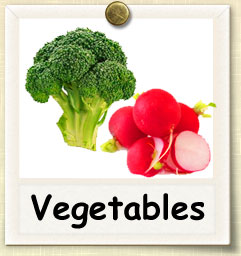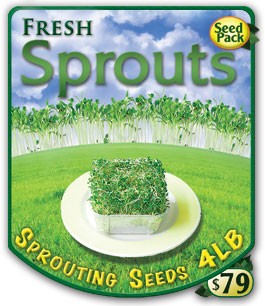|
Home > Guides > Sprouts > Vegetable Sprouts |
|
How to Grow Vegetable Sprouts | Guide to Growing Vegetable Sprouts |
|
|
| |
 |
|
Overview |
|
|
|
|
|
| |
|
| |
Vegetable sprouts show the greatest range of taste and textures. While grain and bean sprouts are often used to add texture or body to dishes, vegetable sprouts add flavor. Perhaps the most notable group of vegetable sprouts are members of the Brassica family, including broccoli, radish, mustard, and others. Many of these sprouts add a spicy, exotic taste that can also be helpful in stimulating digestion. |
|
| |
|
|
| |
Growing Guide
GROWING NOTES
Vegetable seeds are easy to sprout. As with all seeds, cleanliness is absolutely essential. To ensure this, rinse seeds thoroughly and, and even more importantly, drain off all excess water after rinsing. Failure to do this might cause your developing sprouts to sit in water in the bottom of your sprouter, promoting rotting, stunted development, or other undesirable conditions.
Procedure:
- To start your sprouts, you will want to soak your seeds in a bowl of cool water for 4-6 hours, or overnight, making certain that seeds are submersed and not floating on top of the water. This will soften the seed coat and promote germination. After soaking, thoroughly drain off all water. It is wise to rinse seeds immediately after soaking to clean them and wash away an extraneous matter, and again drain off all excess water.
- Wait several hours, then later in that day: Rinse seeds with cool, clean water. Carefully drain off all water so seeds at bottom of sprouter are not covered with water.
- Repeat this process of rinsing with cool water and draining 3-4 times per day as your seeds mature, and even as you begin to harvest and consume them. As your sprouts grow, it is important that they receive good air circulation. Many types of sprouters, such as simple canning jar types, provide good circulation with the tilting motion necessary for complete drainage. Keep your container on your kitchen table or counter, or similar location that has dependable lighting and airflow.
- Once sprouts have reached a desirable state for consumption, they can be transferred out of sprouter and placed under refrigeration to prolong their lifespan. This is not necessary but will slow down the growth process and give you a larger window to eat your sprouts. Sprouts should not be allowed to dry out, as they can quickly lose their vitality and nutritional content.
- Clean sprouter thoroughly after use.
|
|
| |
|
| |
|
|
| |
|
|
| |
Harvesting Guide
HARVESTING
SAVING SEEDS
|
|
| |
|
|
|
| |
|
|

|
|